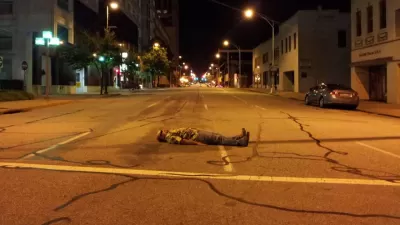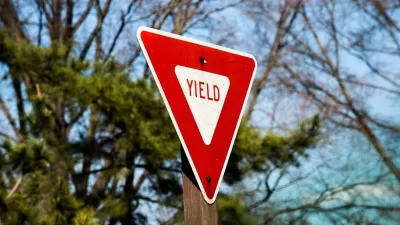Charles Marohn of Strong Towns makes the case that whoever's in the White House, simply increasing federal spending on infrastructure isn't the wisest move.

In this piece, Charles Marohn argues that the relationship local governments have to federal funding is fundamentally unhealthy. He writes, "the way we have structured our governments, cities sit at the bottom of the food chain. Their bureaucracies are oriented up that chain, looking to the programs of state and federal governments for solutions. Instead, they need to be reoriented to the neighborhoods in their own communities."
Marohn cites several ways federal spending can give cities a short-term boost, but saddle them with long-term consequences.
- That the federal government "will pay to build things and then state and local governments are tasked with maintaining them."
- Federal infrastructure spending favors low-density, low-amenity suburbs and exurbs: areas with the highest costs and lowest returns.
- In a slow-growth or no-growth economy, federal spending should to support maintenance and efficiency rather than new construction.
- Federal projects put localities into a debt cycle. "Local governments generally rely on property and sales tax, but federal projects rarely add enough to the local tax base to extinguish the debt while sales tax revenue from a project, if there is any, ends with the project."
FULL STORY: Five Ways Federal Infrastructure Spending Makes Cities Poorer

Alabama: Trump Terminates Settlements for Black Communities Harmed By Raw Sewage
Trump deemed the landmark civil rights agreement “illegal DEI and environmental justice policy.”

Planetizen Federal Action Tracker
A weekly monitor of how Trump’s orders and actions are impacting planners and planning in America.

The 120 Year Old Tiny Home Villages That Sheltered San Francisco’s Earthquake Refugees
More than a century ago, San Francisco mobilized to house thousands of residents displaced by the 1906 earthquake. Could their strategy offer a model for the present?

In Both Crashes and Crime, Public Transportation is Far Safer than Driving
Contrary to popular assumptions, public transportation has far lower crash and crime rates than automobile travel. For safer communities, improve and encourage transit travel.

Report: Zoning Reforms Should Complement Nashville’s Ambitious Transit Plan
Without reform, restrictive zoning codes will limit the impact of the city’s planned transit expansion and could exclude some of the residents who depend on transit the most.

Judge Orders Release of Frozen IRA, IIJA Funding
The decision is a victory for environmental groups who charged that freezing funds for critical infrastructure and disaster response programs caused “real and irreparable harm” to communities.
Urban Design for Planners 1: Software Tools
This six-course series explores essential urban design concepts using open source software and equips planners with the tools they need to participate fully in the urban design process.
Planning for Universal Design
Learn the tools for implementing Universal Design in planning regulations.
Clanton & Associates, Inc.
Jessamine County Fiscal Court
Institute for Housing and Urban Development Studies (IHS)
City of Grandview
Harvard GSD Executive Education
Toledo-Lucas County Plan Commissions
Salt Lake City
NYU Wagner Graduate School of Public Service





























